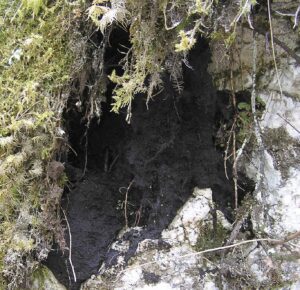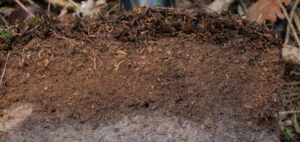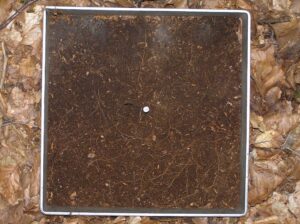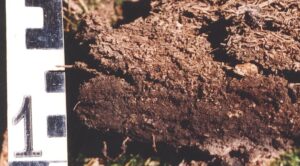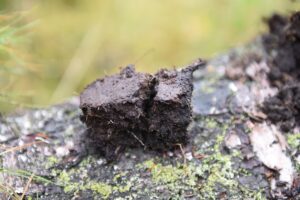Oxh
Oh modified horizon with clearly recognisable droppings of soil fauna, temporarily very high biological activity, thickness ≥ 5 cm.
[x from biological mixed]
- organic carbon content ≥ 15 mass % and
- developed under aeromorphic to aero-hydromorphic conditions
- proportion of organic fine material ≥ 70 vol.%loosely packed and
- material predominantly to exclusively with a fine granular structure
Oxh horizont with a fine granular structure,
diagnostic horizon of Pechmoder, © Gerhard Milbert
Obh
Oh modified horizon, with signs of medium biological activity, recognisable excrements of soil fauna, partly rounded, Obh horizon hard to separate from the mineral soil.
[b from „bröckelig“ (german for friable)]
- organic carbon content ≥ 15 mass % and
- developed under aeromorphic to aero-hydromorphic conditions
- proportion of organic fine material ≥ 70 vol.%
- loosely packed and
- easily breaking to subangular blocky aggregates or powdery material of organic fine matter
Owbh
Obh modified horizon, temporarily influenced by stagnic water or groundwater. Vegetation indicates wetness in the A horizon
[w from water influenced]
- organic carbon content ≥ 15 mass % and
- developed under aeromorphic to aero-hydromorphic conditions
- proportion of organic fine material ≥ 70 vol.%
- temporarily anaerobic conditions and
- when moist, smeary consistency of the black organic fine matter and
- above recently water influenced hydromorphic A or H horizon
Oih
Oh modified horizon, very thin, film-forming horizon at mineral soil surface or thin patches of Oh material here and there.
[i from film-like]
- organic carbon content ≥ 15 mass % and
- developed under aeromorphic to aero-hydromorphic conditions
- proportion of organic fine material ≥ 70 vol.%
- film-forming, thickness < 5 mm or
- thickness ≥ 5 mm and patchy (in pocket-like depressions of the mineral soil surface)
Oih horizon, needle material: Norway spruce (Picea abies) humus form: Mull-like Moder, Cambisol with high base saturation, © Gerhard Milbert
Oih horizon, needle material: Norway spruce (Picea abies) humus form: Mull-like Moder, Cambisol with
high base saturation, © Gerhard Milbert
Ovh
Oh modified horizon, contact with solid rock or coarse material, pH value and base saturation on limestone higher than in the overlaying Oh horizon, contains particles of limestone, high biological activity, very low thickness 1 – 3 cm.
[v from german = vererdet, meaning an increased mineral content]
- organic carbon content ≥ 15 mass % and
- developed under aeromorphic to aero-hydromorphic conditions
- proportion of organic fine material ≥ 70 vol.%
- material is friable under moist conditions, biological active and
- deep black-coloured on limestone, black or deep brown-coloured on lime free material
Okh
Oh transition horizon (Obh-Osh), strongly to extremely acidic, biologically inactive organic fine matter, originated from heather or coniferous litter. Okh horizon easy to separate from the mineral soil, compact, breakable into pieces with blunt or rounded edges, mostly strong to very strong rooting (Figure 19).
[k from german = kompakt; engl. compact]
- organic carbon content ≥ 15 mass % and
- developed under aeromorphic to aero-hydromorphic conditions
- proportion of organic fine material ≥ 70 vol.%
- compact packing and
- the material is breaking in coarse, incompletely separate aggregates with blund or rounded edges and
- aggregates do not fit together without gaps after breaking
Osh
Oh modified horizon, strongly to extremely acidic, consisting of biologically inactive organic fine matter, originated from heather or coniferous litter. The separability between the sharp-edged crushable Osh horizon and the mineral soil is usually very good (Figure 21).
[s from sharp edged]
- compact packing and
- material breaks into aggregates with sharp division surfaces that fit together again without gaps (à Mor)
- organic carbon content ≥ 15 mass % and
- developed under aeromorphic to aero-hydromorphic conditions
- proportion of organic fine material ≥ 70 vol.%
- compact packing and
- material breaks into aggregates with sharp division surfaces that fit together again without gaps (-> Mor)
Owsh
Osh modified horizon, temporarily influenced by stagnic water or groundwater. Vegetation indicates wetness in the A horizon.
[w from water influenced]
- organic carbon content ≥ 15 mass % and
- developed under aeromorphic to aero-hydromorphic conditions
- proportion of organic fine material ≥ 70 vol.%
- compact packing and
- material breaks into aggregates with sharp division surfaces that fit together again without gaps
- temporary anaerobic conditions and
- when moist, smeary consistency of the black organic fine matter and
- above hydromorphic A horizon (-> Moist Mor)

